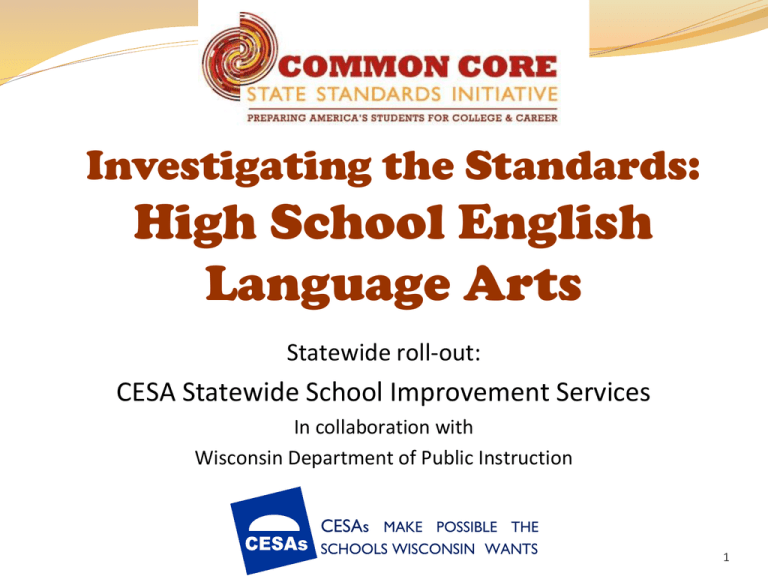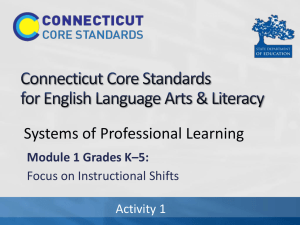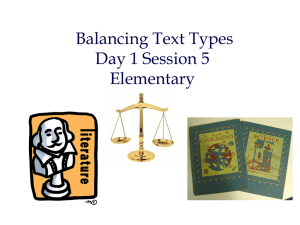ELA Investigations Powerpoint
advertisement

Investigating the Standards: High School English Language Arts Statewide roll-out: CESA Statewide School Improvement Services In collaboration with Wisconsin Department of Public Instruction CESAs MAKE POSSIBLE THE SCHOOLS WISCONSIN WANTS 1 Today’s Agenda Introduction to ELA Common Core State Standards Investigating the Portrait of a Literate Individual Investigating the Standards for Reading Literature Investigating the Standards for Reading Informational Text Investigating the Standards for Writing Investigating the Standards for Speaking and Listening Investigating the Standards for Language Determining Implications and Action Steps 2 Purpose 1. To understand the underpinnings of the CCSS 2. To investigate the High School ELA CCSS 3. To learn a process that can be used to investigate the High School ELA CCSS 4. To plan local investigations of the High School ELA CCSS 5. To reflect about implications to your practice for High School ELA 3 Statewide Roll-Out 4 The Message 1. 2. 3. 4. 5. 6. 7. The Roll-Out is an extended process toward full adoption. The process cannot/should not be rushed – it’s a marathon, not a race. This is one of many collaborative sessions on the CCSS. School/district teacher leaders are needed to lead the process locally. Our focus today is to learn HOW to investigate the High School ELA standards. We aren’t investigating all standards today. You will be given a process that can be duplicated in your school. We won’t be aligning today because alignment cannot be done effectively without careful investigation. 5 To investigate, you will need … Print out of: the English Language Arts Common Core State Standards, K-12 ELA Appendix A ELA Appendix B ELA Appendix C 2. The Investigations Guide 3. Highlighters 4. Pen or pencil 5. Tables for group work 6. Timer/timekeeper 1. 6 Ground Rules for Today InformationGiving Group Work & Recording Attentive listening Open mindset Open mindset to Professional conversations receive new ideas and information Note-taking Careful note-taking (for taking back) Deep thinking Recording of questions – to be addressed later 7 Impetus for the Common Core State Standards Currently, every state has its own set of academic standards, meaning public educated students are learning different content at different rates. All students must be prepared to compete with not only their American peers in the next state, but with students around the world. This initiative will potentially affect 43.5 million students which is about 87% of the student population. 8 CCSS Evidence Base Standards from individual high-performing countries and provinces were used to inform content, structure, and language. Writing teams looked for examples of rigor, coherence, and progression. Mathematics English language arts Belgium (Flemish) Canada (Alberta) China Chinese Taipei England Finland Hong Kong India Ireland Japan Korea Singapore Australia New South Wales Victoria Canada Alberta British Columbia Ontario England Finland Hong Kong Ireland Singapore 9 Development of Common Core Standards Joint initiative of: Supported by: Achieve ACT College Board 10 What’s the Big Deal? The CCSS initiative is a “sea change” in education for teaching and learning! The CCSS mandates the student learning outcomes for every grade level/grade band (HS ELA). The CCSS force a common language. Your staff will begin using this language. Students will be tested and instructional effectiveness will be measured based on CCSS. Federal funding is tied to CCSS adoption, implementation, and accountability. English Language Arts and Mathematics CCSS are just the beginning. . .more subject area standards are being developed. 11 What are the Common Core Standards? “Common Core Standards define the knowledge and skills students should have within their K-12 education careers so that they will graduate high school able to succeed in entry-level, credit-bearing academic college courses and in workforce training programs.” (NGA & CCSSO, 2010) http://www.corestandards.org/ 12 A Vision for Implementation 13 Investigating the Standards: CCSS High School English Language Arts 14 Overall ELA Structure K-5 6-12 ELA 6-12 Literacy in History/Social Studies, Science & Technical Subjects Appendix A Appendix B Appendix C Reading Language ELA Writing Speaking & Listening 15 Key Design Features CCR (College and Career Readiness) & Grade specific standards Grade Levels and Grade Bands Focus on Results Integrated Model of Literacy Research and Media Blended Shared Responsibility p. 4 in the standards 16 College and Career Readiness Anchor Standards Flowing throughout all strands of standards Anchoring the document Defining general, cross-disciplinary literacy expectations Defining expectations that must be met for entry into college and workforce training programs Expressing cumulative progressions through the grades to meet CCR by end of high school Using CCR and High School Standards to work in tandem to define the college & career readiness line 17 Activity #1 Portrait of a Literate Individual Students who are college and career ready in English Language Arts … Demonstrate independence Build strong content knowledge Respond to varying demands of audience, task, purpose and discipline p. 7 in the Comprehend as well as critique standards Value evidence Use technology and digital media strategically and capably Understand other perspectives and cultures 18 Activity #1 Activity #1: Portrait of a Literate Individual Page 7 Read the descriptions of characteristics of a literate individual on page 7. Discuss each student characteristic. What might this look like? Take notes on the organizer. Watch your time (10 minutes). 19 Reading Language ELA Writing Speaking & Listening 20 K-5 Structure (Birds-Eye View) Section K-5 ELA Standards Progress with increasing levels of sophistication by grade K through 5 Strands: •READING & CCR Reading Anchor Standards •Reading Literature •Reading Informational Text •Foundational Skills (K-5) •WRITING & CCR Writing Anchor Standards •SPEAKING & LISTENING & CCR Speaking & Listening Anchor Standards •LANGUAGE & CCR Language Anchor Standards Across the Curriculum Standard 10 Range, Quality and Complexity of Student Reading K-5 & Range of Writing 21 6-12 Structure(Birds-Eye View) Section 6-12 ELA Standards Progress with increasing levels of sophistication By grade & grade bands (6, 7, 8, 9-10, 11-12) Strands: •READING & CCR Reading Anchor Standards •Reading Literature •Reading Informational Text •WRITING & CCR Writing Anchor Standards •SPEAKING & LISTENING & CCR Speaking & Listening Anchor Standards •LANGUAGE & CCR Language Anchor Standards Standard 10 Range, Quality and Complexity of Student Reading 6-12 & Range of Writing 22 6-12 Structure, continued Literacy in History/Social Studies, Science and Technical Subjects By grade bands (6-8, 9-10, 11-12) • READING & CCR Reading Anchor Standards • History/Social Studies • Science & Technical Subjects • WRITING & CCR Writing Anchor Standards • History/Social Studies, Science & Technical Subjects 23 Reading Language ELA Writing Speaking & Listening 24 READING & CCR Reading Anchor Standards •Reading Literature •Reading Informational Text 25 Activity #2 College & Career Readiness Anchor Standards for Reading Page 35 CCR Categories for Grades 6-12 Key Ideas and Details Craft and Structure Integration of Knowledge and Ideas Range of Reading and Level of Text Complexity Major Organizing Structure Throughout the Reading Standards Specific Standards are Provided in Each Category by Grade Level/Band 26 Activity # 2: Investigating College & Career Readiness Anchor Standards for Reading Activity #2 WIDE WIDE DEEP Task: Read the CCR Reading standards for grades 6-12 on page 35. Discuss the major concepts in each CCR category. Complete the chart provided with your thinking. --------------------------------------------------------------------------------------- Read the paragraph (Range and Content of Student Reading) in italics on the right of page 35. Highlight key words and phrases. Discuss your thinking about range and content of text with your table partners, and make notes below the chart. Watch the time (15 minutes) 27 Activity #3 Reading Standards for Literature Page 38 Note the grade bands Grades 9-10 Grades 11-12 Note CCR Categories Each category provides specific reading (literature) standards by grade band 28 Activity #3 Activity # 3: Levels of Pages 36-38 Sophistication in Reading Literature Task Note the standards beginning with Grade 8 through Grade 12. Divide these CCR categories among your table partners: Key Ideas & Details Craft & Structure Integration of Knowledge & Ideas Range of Reading & Text Complexity Read the specific standards in the CCR category from grades 8 through 12. Note “key words” that show progressions of sophistication on the chart provided. Share your findings and thinking with your table partners. Watch the time (15 minutes). 29 Activity #4 Reading Standards for Informational Text “There is also evidence that current standards, curriculum, and instructional practice have not done enough to foster the independent reading of complex text so crucial for college and career readiness, particularly in the case of informational text.” CCSS ELA Appendix A, p. 3 “…expository text makes up the vast majority of the required reading in college and the workplace.” CCSS ELA Appendix A, p. 3 30 Activity #4 Reading Standards for Informational Text, continued “Worse still, what little expository reading students are asked to do is too often of the superficial variety that involves skimming and scanning for particular discrete pieces of information; such reading is unlikely to prepare students for the cognitive demand of true understanding of complex text.” CCSS ELA Appendix A, p. 3 31 Reading Standards for Informational Text, continued Activity #4 “Moreover, current trends suggest that if students cannot read challenging texts with understanding—if they have not developed the skill, concentration and stamina to read such texts—they will read less in general.” “In particular, if students cannot read complex expository text to gain information, they will likely turn to text-free or text-light sources, such as video, podcasts and tweets. These sources, while not without value, cannot capture the nuance, subtlety, depth or breadth of ideas developed through complex text.” CCSS ELA Appendix A, p. 3 32 Activity #4: The Importance of Informational Text Activity #4 Task: Go to page 4 in Appendix A. Find paragraph #2 beginning “Being able to read …” and paragraph #3 beginning “It should be noted …” Read these two paragraphs to investigate the importance of informational text in the standards. Write your “aha’s and questions” on the Activity #4 chart provided and think about and discuss examples you could use in ELA classes. Watch the time (10 minutes). 33 Activity #5 Investigating Reading Standards for Informational Text Go to Page 40 in the ELA standards. Note that informational text standards are within grade bands (9-10, 11-12) Note the same CCR Categories, but with specific informational text standards per category 34 Activity #5: Reading Informational Text Standards Activity #5 Task: Place page 38 (Literature Standards) and page 40 (Informational Text) side-by-side in front of you. Choose a CCR category and its corresponding standards to investigate (both 9-10 and 11-12 grade bands). Compare and contrast the major concepts of the literature text standards and informational text standards for the selected category. Note and discuss major concepts that are different. Watch the time (15 minutes). 35 Activity #6 CCR Standard 10 Range of Reading and Text Complexity 10. Read and comprehend complex literary and informational texts independently and proficiently. 36 Activity Standard 10 The Standards’ Approach to Text Complexity •Appendix A, pp. 4-10 #6 •3-part model of text complexity •Equally important considerations of text complexity •To be used with the 9 reading standards Reader and Task 37 Standard 10 Activity #6 Qualitative evaluation of the text (p. 5 & 6, Appendix A) Levels of meaning, structure, language conventionality and clarity, and knowledge demands Quantitative evaluation of the text (p. 7 & 8) Readability measures and other scores of text complexity Matching reader to text and task (p. 9) Reader variables (such as motivation, knowledge, and experiences) and task variables (such as purpose and the complexity generated by the task assigned and the questions posed) Progression of Standard 10 Note K-12 progressions in text complexity (p. 10, Appendix A) •Note reference in the CCSS to the Lexile Framework in pages 7-8, Appendix A. •Page 8 in Appendix A provides a chart with new Lexile ranges (ex. 1080L1305L for gr. 9-10) aligned to CCR expectations. •More information is included from http://lexile.com/. 38 Activity #6: Investigating Text Complexity Dimensions Activity #6 Task Go to Appendix A, pages 4-10. Assign each of the three dimensions to your table partners (qualitative, quantitative, reader & task). Read the descriptions of each dimension and note key concepts in the graphic organizer provided. Share your readings and thoughts. Discuss the importance of each and how to balance all three when selecting texts for students. Watch the time (15 minutes). 39 Activity #7 Analyzing Texts That Have Appropriate Challenges for Students Guiding Questions: How do you make informed decisions about choosing appropriate texts for students to read? How do you insure that all students are exposed to texts that are appropriate for them to read as well as exposing them to increasing text complexity? 40 Activity #7: Analyzing Text Complexity Activity #7 Task: Go to Appendix A, pages 11-16. Examine the three samples of text passages provided. Note the analysis chart that follows each passage (Figures 5, 6, & 7). Study the passage and its analysis according to the three dimensions (qualitative, quantitative, and reader-task). Use the chart to note observations about each dimension and discuss them with your table partners. Note that Lexile scores have been included for each excerpt based on the Lexile text analyzer at Lexile.com. Answer and discuss the two questions that follow. Watch the time (15 minutes). 41 Choosing Appropriate Texts Note exemplars in Appendix B Factors for text selection: complexity, quality and range The text exemplars provided on the CCSS list in Appendix B are … Examples only Not required reading See Separate Handout WCTE Article Sept. 2010 Exemplars provided are LIMITED in … Including multicultural examples Current young adult literature (that students would find relevant and meaningful) 42 Reading Language ELA Writing Speaking & Listening 43 Standards for Writing CCR for Writing K-5 6-12 Appendix C 44 Activity #8 College & Career Readiness Anchor Standards for Writing Page 41 CCR Categories for Grades 6-12 Text Types & Purposes Production & Distribution of Writing Research to Build & Present Knowledge Range of Writing Major Organizing Structure Throughout the Writing Standards Specific Standards are Provided in Each Category by Grade Level/Band 45 Activity #8: Investigating College & Career Standards for Writing Activity #8 Task: Read the CCR Writing standards for grades 6-12 on page 41. Discuss the major concepts in each CCR category. Complete the chart provided with your thinking. -------------------------------------------------------------------------------- Read the paragraph (Range and Content of Student Writing) in italics on the right of page 41. Highlight key words and phrases. Discuss your thinking about range and content of text with your table partners, and make notes below the chart. Watch the time (15 minutes). 46 Standards for Writing: Text types, Activity #9 responding to reading, and research “The Standards acknowledge the fact that whereas some writing skills, such as the ability to plan, revise, edit, and publish, are applicable to many types of writing, other skills are more properly defined in terms of specific writing types: arguments, informative/explanatory texts, and narratives. Standard 9 stresses the importance of the writing-reading connection by requiring students to draw upon and write about evidence from literary and informational texts. Because of the centrality of writing to most forms of inquiry, research standards are prominently included in this strand, though skills important to research are infused throughout the document.” CCSS page 8 47 Activity #9: Investigating Writing Standards Activity #9 Task: Read the section in Appendix A, pages 23-25. Highlight major ideas that will impact your writing instruction and note them in the chart that follows. Look carefully at the “Text Types & Purposes” standards 1, 2, and 3 on pages 45-46. List key student work that will be expected as you teach these standards. Peruse the other CCR Writing standards for grades 9-12 on pages 45-47 and note key student expectations in these standards. Watch the time (10 minutes). 48 Reading Language ELA Writing Speaking & Listening 49 Speaking & Listening Standards: Activity # 10 Flexible Communication & Collaboration Including but not limited to skills necessary for formal presentations, the Speaking and Listening standards require students to develop a range of broadly useful oral communication and interpersonal skills. Students must … • learn to work together, • express and listen carefully to ideas, • integrate information from oral, visual, quantitative, and media sources, • evaluate what they hear, • use media and visual displays strategically to help achieve communicative purposes, and • adapt speech to context and task. 50 Interrelationship Between Oral and Written Language Oral Language Written Language Activity # 10 Receptive Language Expressive Language Listening Speaking Reading (Decoding & Comprehension) Writing (Handwriting, Spelling & Written Composition) 51 Activity # 10 Listening & Reading Comprehension Sticht & James 1984 Comprehension Page 26 1 2 3 4 5 6 7 8 9 10 11 12 13 14 Age 52 Activity # 10: Investigating Listening & Speaking Standards Activity # 10 Task 1: Read the paragraph (Range & Content of Student Speaking and Listening) in italics on the right side of page 48. In the organizer make a note of the “intent” of these standards. --------------------------------------------------------------------------------------------Task 2: Look at the CCR (College & Career Readiness) standards on page 48. Using the organizer provided, note the key ideas in the CCR standards for Comprehension and Collaboration and Presentation of Knowledge and Ideas. --------------------------------------------------------------------------------------------Task 3: Look specifically at the expectations for grades 9-10, and 11-12 in each of the CCR standards. Note and discuss key specific student expectations in the chart provided. Watch the time (12 minutes). 53 Reading Language ELA Writing Speaking & Listening 54 Activity # 11 Language Standards: Conventions, Effective use, and Vocabulary “The Language standards include the essential “rules” of standard written and spoken English, but they also approach language as a matter of craft and informed choice among alternatives.” “The vocabulary standards focus on understanding words and phrases, their relationships, and their nuances and on acquiring new vocabulary, particularly general academic and domainspecific words and phrases.” CCSS page 8 55 Activity # 11 Interrelationships Between the Language Standards and other ELA Standards “In many respects, however, conventions, knowledge of language, and vocabulary extend across reading, writing, speaking, and listening. Many of the conventions-related standards are as appropriate to formal spoken English as they are to formal written English. Language choice is a matter of craft for both writers and speakers. New words and phrases are acquired not only through reading and being read to but also through direct vocabulary instruction and (particularly in the earliest grades) through purposeful classroom discussions around rich content.” CCSS Appendix A, page 28 “The inclusion of Language standards in their own strand should not be taken as an indication that skills related to conventions, knowledge of language, and vocabulary are unimportant to reading, writing, speaking, and listening; indeed, they are inseparable from such contexts.” CCSS Appendix A, page 28 56 Activity # 11: Investigating CCR Standards for Language Activity # 11 Task: Read the paragraph (Range and Content in Student Language Use) in italics on the right side of page 51. Discuss and note the Big Ideas in Box A. ------------------------------------------------------------------------------ Discuss and note the CCR (College & Career Readiness) Standards on page 51. Make observations regarding what the emphasis is in these standards in Box B. Watch your time (10 minutes). 57 Activity # 12 Activity #12: Investigating Knowledge of Language and Vocabulary Acquisition and Use Task: Look at the standards on page 54-55. Note the standard marked with an (*). Now note the language progression chart on page 56. Discuss and note the progressive skills* on the chart that are expected to require continued attention throughout the grades and into high school. Discuss and note your observations in Box A. Study the “Knowledge of Language” standards for grades 6, 7, 8, 9-10 and 11-12 on pages 52 to 54. Discuss and note your observations about knowledge of language and expectations for student understanding in Box B. Look at the standards for Vocabulary Acquisition and Use on page 55. Discuss and note student expectations for students in grade 912 in Box C. (See also Appendix A, pages 32-35 for more background information on Vocabulary acquisition). Watch the time (15 minutes). 58 Activity #13-14 Determining Implications and Next Steps We’ve been investigating the standards – now, what’s next? 59 Activity #13-14 Activity #13: Determining Implications Task: Now that you’ve started the process of “investigating” the standards, discuss the implications for fellow teachers and staff. Use the chart to note your thoughts. Watch the Timer to close this activity when the time is up. Activity #14: Determining Next Steps Reflect on the activities completed today. How will you take this process back to your colleagues for investigations at your school/district? Jot your “next steps” in the chart provided. Foundations for the Investigation Guide 60 How Are You Doing? Foundations for the Investigation Guide 61 Feedback Please complete the Exit Ticket provided. Thanks so much for your participation! Best of luck! Claire Wick CESA 7 Literacy Coordinator and School Improvement Specialist cwick@cesa7.k12.wi.us 62




